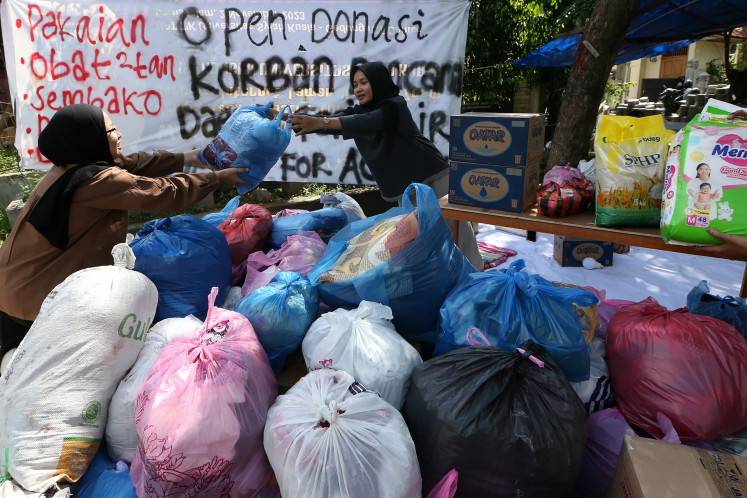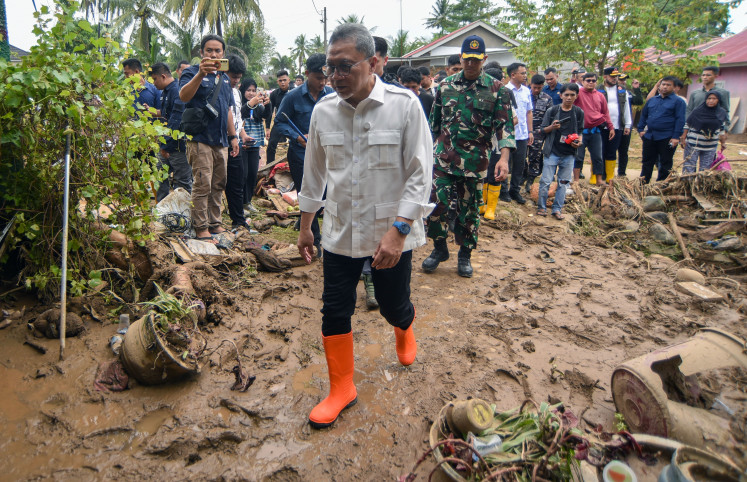Popular Reads
Top Results
Can't find what you're looking for?
View all search resultsPopular Reads
Top Results
Can't find what you're looking for?
View all search resultsRains on Mt. Sinabung trigger dangerous cold lava flows
Residents and evacuated persons living near Mount Sinabung in Karo regency, North Sumatra, are being urged to stay alert to the threat of cold lava flows that could reach several villages following heavy rains over the past three days
Change text size
Gift Premium Articles
to Anyone
R
esidents and evacuated persons living near Mount Sinabung in Karo regency, North Sumatra, are being urged to stay alert to the threat of cold lava flows that could reach several villages following heavy rains over the past three days.
'Villages located along Lau Boras River should be cautious as the river is the only route for the cold lava, which will be heading toward residential areas,' Mt. Sinabung emergency disaster response commander Lt. Col. Asep Sukarna told The Jakarta Post on Monday.
He added that the villages at risk included Suka Meriah, Gurukinayan, Sei Bekerah and Batu Karang, areas that have been reoccupied by residents after being abandoned for months following an eruption last year.
Asep said that even though the villages were situated beyond the 3-km danger zone radius, they were still at risk of cold lava flows, particularly in Batu Karang village. To date, he said, the volume of cold lava flowing to Batu Karang was still small and yet in sufficient quantities to endanger the local population.
Gurukinayan village resident Netta Sembiring, who has yet to return home after last year's eruption, said some residents were still afraid to return home because volcanic activity remained high, suggesting the possibility of further eruptions.
'Pyroclastic clouds, cold lava and volcanic ash can threaten the safety of residents anytime. We prefer staying at the shelter until the situation returns to normal,' said Netta, who has received financial assistance for a lease on a house from the government.
Head of Mt. Sinabung volcano observation post Armen Putra said at the time being, low overall levels of precipitation had reduced the risk of cold lava flow, but that heavy rains at the summit would significantly raise the risk level.
- Heavy rains prompt officials to issue warning regarding threat of cold lava flows in Karo regency
- Mt. Sinabung still emitting pyroclastic flows and volcanic ash
- Business in Berastagi city has begun to recover
'In the event of heavy rains at the peak, residents living along the river must be prepared to evacuate because cold lava flows will travel quickly down the mountain and can sweep away people's homes,' said Armen.
Armen added that volcanic activity remained high. He said that as of Monday afternoon, Mount Sinabung had discharged pyroclastic flows six times toward the south, causing volcanic ash to billow toward to the west.
Several villages located in the west, such as those in Payung district, are currently covered by ash.
The situation in Berastagi city, which was paralyzed by the volcanic ash last week, has gradually returned to normal and the hotel occupancy rate has picked up.
'Many guests booked rooms at our hotel yesterday,' Hotel Sibayak general manager Mustika told the Post on Monday.
Mustika expressed the hope that the Mount Sinabung eruption would not continue to disrupt tourism in the city and the surrounding areas.
The volcano first erupted in September of last year, displacing more than 33,000 residents. In February, 14 people were killed and three others severely injured after the volcano suddenly spewed hot ash.
As of Oct. 5, 3,287 evacuees from 1,019 families remained in 16 evacuation centers.










